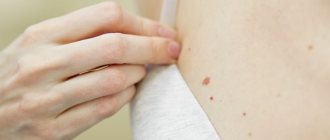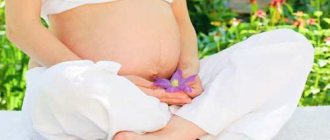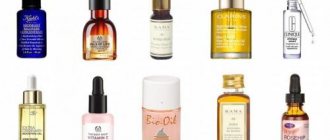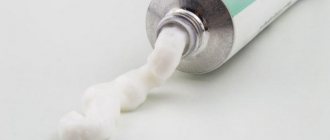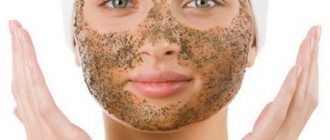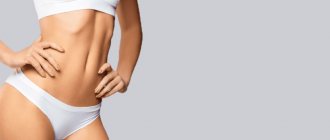Often, experienced obstetricians and gynecologists can tell that a patient is pregnant without resorting to an examination or special laboratory tests—the first glance at the woman is enough for them. This data cannot be included in the documentation, but you can notice these changes yourself by looking at yourself in the mirror.
During the period of bearing a baby, all the activities of the expectant mother’s body are aimed at ensuring normal growth of the fetus and maintaining the necessary conditions that ensure its development according to a genetically encoded plan. Pregnancy affects the functioning of all systems of the mother’s body: endocrine, nervous, cardiovascular, respiratory, digestive, immune, urinary; The condition of the skin, hair and nails also changes.
Body care
First of all, pregnancy and cosmetics are not mutually exclusive concepts; it’s just that while you’re expecting a baby, it’s better to give preference to natural and hypoallergenic products. Now there are quite a few brands to suit a variety of budgets with lines of care products for pregnant women.
If you don't trust them, you can try using homemade recipes based on natural ingredients. Olive oil, coconut oil, wheat germ oil and almond oil perfectly moisturize the body and help fight against stretch marks. To improve the condition of your body skin, you can use a sugar or salt scrub once or twice a week: simply apply fine salt in a circular motion to damp skin, and then rinse with water.
Sources
- Ross-Davie M., Brodrick A., Randall W., Kerrigan A., McSherry M. 2. Labor and birth. // Best Pract Res Clin Obstet Gynaecol - 2021 - Vol - NNULL - p.; PMID:33879365
- Sabharwal V., Bartolome R., Hassan SA., Levesque BM., Camelo IY., Wachman EM., Figueira M., Yarrington CD., Cooper ER., Barnett ED., Parker MG. Mother-Infant Dyads with COVID-19 at an Urban, Safety-Net Hospital: Clinical Manifestations and Birth Outcomes. // Am J Perinatol - 2022 - Vol - NNULL - p.; PMID:33853145
- Yu Y., Zhang Y., Zhu X., Zhang C., Tong C., Zhao Y. . // Zhonghua Wei Zhong Bing Ji Jiu Yi Xue - 2022 - Vol33 - N3 - p.305-310; PMID:33834971
- Bezemer JM., van der Ende J., Limpens J., de Vries HJC., Schallig HDFH. Safety and efficacy of allylamines in the treatment of cutaneous and mucocutaneous leishmaniasis: A systematic review. // PLoS One - 2022 - Vol16 - N4 - p.e0249628; PMID:33826660
- Elango K., Javaid A., Khetarpal B.K., Ramalingam S., Kolandaivel K.P., Gunasekaran K., Ahsan C. The Effects of Warfarin and Direct Oral Anticoagulants on Systemic Vascular Calcification: A Review. // Cells - 2022 - Vol10 - N4 - p.; PMID:33807457
- Foessleitner P., Kiss H., Deinsberger J., Ott J., Zierhut L., Farr A. Validation of the SavvyCheck™ Vaginal Yeast Test for Screening Pregnant Women for Vulvovaginal Candidosis: A Prospective, Cross-Sectional Study. // J Fungi (Basel) - 2022 - Vol7 - N3 - p.; PMID:33804805
- Gonçalves-Ferri WA., Pereira-Cellini FM., Coca K., Aragon DC., Nader P., Lyra JC., do Vale MS., Marba S., Araujo K., Dias LA., de Lima Mota Ferreira DM ., Nieto G., Anchieta LM., de Cássia Silveira R., de Moura MDR., Tuma Calil VML., Moraes VCC., de Almeida JHCL., Magalhães M., Sonini TCB., Javorsky JB., Ribeiro ÉLA. , Ferreira R., de Almeida LDC., Garbers R., da Silva Faria GM., Roosch A., de Mesquita ARA., de Oliveira Pinto RM. The impact of coronavirus outbreak on breastfeeding guidelines among Brazilian hospitals and maternity services: a cross-sectional study. // Int Breastfeed J - 2021 - Vol16 - N1 - p.30; PMID:33789708
- Gurung R., Ruysen H., Sunny AK., Day LT., Penn-Kekana L., Målqvist M., Ghimire B., Singh D., Basnet O., Sharma S., Shaver T., Moran AC., Lawn JE., Kc A. Respectful maternal and newborn care: measurement in one EN-BIRTH study hospital in Nepal. // BMC Pregnancy Childbirth - 2022 - Vol21 - NSuppl 1 - p.228; PMID:33765971
- Ameen S., Siddique AB., Peven K., Rahman QS., Day LT., Shabani J., Kc A., Boggs D., Shamba D., Tahsina T., Rahman AE., Zaman SB., Hossain AT ., Ahmed A., Basnet O., Malla H., Ruysen H., Blencowe H., Arnold F., Requejo J., Arifeen SE., Lawn JE., Rahman QS., Rahman AE., Tahsina T., Zaman SB., Ameen S., Hossain T., Siddique AB., Hossain AT., Mazumder T., Khan J., Talha TUS., Haider R., Rahman MH., Ahmed A., El Arifeen S., Basnet O., Sunny AK., Thakur N., Gurung R., Jha AK., Jha B., Bastola RC., Paudel R., Paudel A., Kc A., Salim N., Shamba D., Shabani J. , Shirima K., Tarimo MN., Mbaruku G., Masanja H., Day LT., Ruysen H., Peven K., Gordeev VS., Gore-Langton GR., Boggs D., Kong S., Baschieri A. , Cousens S., Lawn JE. Survey of women's report for 33 maternal and newborn indicators: EN-BIRTH multi-country validation study. // BMC Pregnancy Childbirth - 2022 - Vol21 - NSuppl 1 - p.238; PMID:33765956
Facial care
To care for oily skin, as well as when acne appears, it is better to avoid using special creams, as they usually contain dangerous salicylic acid. You can improve the condition of problematic facial skin during pregnancy using folk remedies, using, for example, a mask based on dry yeast.
Dry skin also needs special care while expecting a baby: you should not use soap to remove makeup, it is better to use a moisturizing gel for washing and choose a cream containing vitamin E and aloe vera.
Contraindications
During this period, it is not recommended to carry out certain procedures and use products that help get rid of cellulite:
- essential oils - they affect not only you, but also the fetus, some of them are neurotoxic - they can provoke negative consequences on the development of the child;
- hardware electrotherapy of cellulite and hydromassage;
- anti-cellulite underwear;
- anti-cellulite cosmetics - the chemical components that are included in the composition are of no use to you now;
- hot wrap - increases blood circulation, increases body temperature - this can lead to serious problems.
At this point in your life, you should take care of the health of yourself and your baby. After giving birth, you can safely begin to get rid of cellulite and excess deposits using all available methods. Hardware salon procedures are the most effective.
Hair care
Many women note that during pregnancy, hair becomes less brittle and practically does not fall out. All this is the result of hormonal changes that occur in the body while expecting a baby. However, protection and hydration are still your hair's best friends, and choosing natural shampoos and hair masks won't be too difficult. Ideally, they contain organic plant substances.
To reduce the adverse effects on the body of daily use (and therefore inhalation) of hairspray, it is better to replace it with fixing foams, emulsions, waxes, etc.
Gentle paints without ammonia and tinted shampoos, if used within reasonable limits, will not cause much harm. It is better not to buy ordinary household paints for home use in the store, but to go to a good salon and consult a professional hairdresser about what is suitable for you during pregnancy.
Hair coloring can be done using natural dyes - henna or basma. However, it is worth considering that such coloring will be very durable and ordinary factory-made dyes, if you then decide to use them, will not last - you will have to wait until the henna-dyed hair grows out and you can cut it off.
PREGNANCY AND APPEARANCE: ARE ALL THE CHANGES FOR THE BETTER?
Does pregnancy always help clear your skin?
Experts rarely hear that skin condition improves during pregnancy. More often it happens the other way around. During pregnancy, acne may appear on the face, chest or back.
The sebaceous glands are responsible for the production of androgen (male sex hormone), the amount of which increases in the female body during pregnancy. Due to this, the sebaceous glands produce more sebum, which clogs the pores, which leads to the formation of acne. After childbirth, the skin usually recovers.
For acne, safe topical medications available on the market can be used. Also, do not forget about daily cleansing of the skin using pharmaceutical hygiene products containing alpha hydroxy acids, which can minimize skin problems and improve its appearance.
Another problem associated with skin diseases is chloasma or the “mask of pregnancy.” It appears on the skin under the influence of the sun in the upper cheek area, on the forehead, above the upper lip. Has a brown/brownish color. The reason is hyperpigmentation in the upper layers of the skin, as well as taking contraceptive medications.
Usually, after pregnancy this skin defect disappears. But in some cases it persists, then salon whitening procedures and special home care (whitening creams, serums, tonics, masks) will come to the rescue.
It is important to use sunscreen during pregnancy to prevent the formation of pigmentation or to stop further pigmentation of existing spots.
Other skin diseases - Pruritic urticarial papules and plaques of pregnancy (PUPP) are the most common skin disease, usually observed in the last trimester of pregnancy.
Women with PDHD develop small red rashes that look like hives and then develop into larger spots. They usually occur in the abdomen and then spread to the thighs, buttocks, chest and arms.
Suitable antipruritic and antihistamine medications recommended by your doctor will help you cope with itching.
Is it possible to avoid the appearance of stretch marks on the skin?
A painful problem that occurs in more than 90% of cases. The formation of stretch marks is associated with a rapid increase in body weight and volume (or with rapid loss of body weight after childbirth), as a result of which the skin stretches and pinkish-white or lilac stripes form on the body (abdomen, chest, thighs, etc.).
To prevent stretch marks, it is recommended to regularly use special cosmetics - lotions, creams with alpha hydroxy acids that prevent the appearance of stretch marks. To achieve maximum effect, it is desirable that this cosmetics be pharmacy or professional.
Moderate physical activity and gymnastics for pregnant women are also useful, but after consultation with your doctor.
Do hormones often affect hair growth and condition during pregnancy?
The appearance of hair in the chin area, above the upper lip, etc., is more typical for men, but, unfortunately, occurs in women. May be caused by hormonal changes during pregnancy. As a rule, such signs disappear six months after the birth of the child.
But there is another problem - 3 months after giving birth, many women begin to lose hair. This loss is otherwise called telogen effluvium, and the hair usually returns soon. However, treatment should be carried out under the supervision of a dermatologist.
Other troubles
- The structure of the nails may become brittle and the surface may become rough.
- Birthmarks may change color under the influence of hormones, and scars may increase in size.
After childbirth, these defects either disappear or become less noticeable.
Is it possible to lose weight without dieting?
After the birth of a baby, many mothers have to deal with the problem of extra pounds. If your weight gain during pregnancy was 10-15 kg, then it will take several months to return to your previous parameters, provided that you monitor your diet and physical activity.
Experts say it's important to take a gradual approach to weight loss. And return to the usual way of life and previous standards when the body is really ready.
One of the main points in working on yourself is to be patient, since the pregnancy lasted 9 months. And at least the same amount of time may be required to restore and regain its previous form.
It may seem strange, but sticking to any particular diet can negate all efforts to combat excess weight. By returning to proper healthy eating to satisfy hunger, most women begin to lose weight naturally.
Instead of following a diet, doctors recommend a balanced, varied diet rich in vitamins and microelements to satisfy hunger and give you energy. You need to eat small portions 4-5 times a day.
No matter how much weight you want to lose, try to stay below 1,800 calories per day, especially if you're breastfeeding.
Superfoods for health
The body of a young mother needs maximum consumption of nutrients, especially if all the care for the baby falls on your shoulders.
Focus on the following products:
- Fish is rich in polyunsaturated fatty acids (Omega-3), which contribute to the mental development of the child and the formation of a healthy nervous system. Best sources of Omega-3: salmon, sardines and tuna (light variety is best; albacore contains high concentrations of mercury).
- Milk and yogurt are rich in calcium, which is necessary for mother and child to maintain and form a strong skeletal system.
- Protein foods (lean meats, chicken and legumes) are low in calories and rich in protein and fiber. Promotes a feeling of fullness for a long time.
Correct drinking regime
Adequate water content in the body (at least 8 glasses per day) will maintain hydration levels, regulate appetite and increase metabolism.
However, doctors recommend determining the required amount of water individually - by the color of urine (clean, light) and regular visits to the toilet (every 3-4 hours).
Moderate physical activity
To stay toned, aerobic exercise and stretching exercises are necessary. Physical exercise helps fight depression, solve sleep problems, and relieve stress. It is enough to do 20-30 minutes a day, dividing the set of exercises into 10-minute intervals. Include exercises with light weights (dumbbells), walking with your baby is also a warm-up.
Today there are also many sports and fitness centers that offer special recreational activities for infants and older children.
But first, consult your doctor.
Try to get more sleep at night; at least 8 hours are required to recuperate. If your child is restless, sleep when he sleeps.
Be healthy!
Source: Sofia Milovanova, journalist
Nail care
Manicure and pedicure are an important part of personal care. But frequent inhalation of nail polish and nail polish remover fumes is far from beneficial, especially if you're sitting in a crowded or poorly ventilated salon area. You can be content with a home manicure and pedicure, including various softening and strengthening baths, correction of nail plates, and polishing. And to paint your nails, it is better to choose varnishes without toluene, dibutyl phthalate and formaldehyde. Nail polish remover should be soy or water based, without acetone.
How to maintain your figure during pregnancy
“Regular care” is a simple answer to the question of how to maintain body quality and remove stretch marks after pregnancy. By constantly nourishing your skin and caring for it properly, you maintain the amount of collagen and elastin in the cells and prevent stretch marks, dryness and inflammation.
| We introduce you to ARAVIA Organic products, which are safe for the health of mother and baby, do not contain parabens, mineral oil and animal products. Their action is aimed at maintaining figure and skin care during and after pregnancy. |
Decorative cosmetics
The main rule for pregnant women when using decorative cosmetics is to choose hypoallergenic products. It is advisable to leave the makeup itself as light as possible: a touch of lipstick, a light application of mascara, a little eye shadow and a soft touch of blush. Foundation and powder can clog pores, so give preference to a light fluid or mineral powder. As a decorative product for lips during pregnancy, it is better to choose moisturizing balms with a light shade.
Fragrances
During pregnancy, especially in the first trimester, the expectant mother may be especially sensitive to odors, so there is a chance that even the smell of her favorite perfume will seem too intense or unpleasant to her. If increased sensitivity to fragrances has appeared, it is better not to torment yourself, but to stop using perfume or eau de toilette for a while and choose cosmetics without fragrances (as a rule, brands of “pharmacy” cosmetics based on thermal water have such options).
During pregnancy, hormonal changes often lead to active sweating and increased natural odors. When choosing a deodorant, it is better to give preference to one that does not contain alcohol, parabens and aluminum. In natural and organic cosmetics stores, you can choose special talc or powder that will prevent the appearance of sweat odor.
Vascular changes
Telangiectasia
Telangiectasias (“spider veins”) present as a red dot with surrounding erythema radiata and most often appear on skin drained by the superior vena cava, including the face, neck, and arms. They first appear in the second to fifth months of pregnancy and tend to increase in size and number as labor approaches. By 7 weeks of the postpartum period, about 75% of telangiectasias disappear. A large study reported the presence of telangiectasia in 67% of pregnant women compared with 15% of nonpregnant Caucasian women, most likely due to increased levels of circulating estrogens.
Palmar erythema
Palmar erythema is one of the most common vascular changes during pregnancy (in 35% of black and 62.5% of light-skinned patients) and often occurs in conjunction with telangiectasia. Erythema can appear in one of two forms: as an erythematous, sharply demarcated area that is localized to the hypothenar or thenar, or as a mottling over the entire surface of the palm. The supposed cause of these changes is the high level of estrogen in the blood, so palmar erythema quickly regresses, disappearing within one week after birth.
Granuloma of pregnancy
Granuloma of pregnancy, or “tumor of pregnancy,” is a lesion of the oral cavity in the form of a loose, pedunculated, erythematous nodule, similar to pyogenic granuloma. Typically, granuloma appears in the third month of pregnancy, then constantly increases in size. The etiology of this formation is unknown, but it does not cause harm to health, and therefore removal is required only in case of increased bleeding or with a large volume of damage in order to avoid discomfort.
Phlebeurysm
About 40% of pregnant women develop varicose veins. The veins of the lower extremities are most often affected, which leads to swelling and pain, and sometimes to vascular thrombosis. Less commonly, varicose veins of the vulva, vagina and/or anus may be observed.
The causes of varicose veins are a decrease in vascular tone, as well as impaired venous return due to a mechanical obstruction to the outflow of blood. It is believed that after childbirth, varicose veins partially regress, so any surgical interventions should be postponed until after delivery. However, during pregnancy, conservative symptomatic therapy is widely used. Help for varicose veins of the lower extremities includes avoiding prolonged sitting or lying down, wearing elastic stockings, and elevating the legs while lying down. While for hemorrhoids, sitz baths, local anesthetics, astringent compresses and laxatives may be helpful.
Pregnant stripes
Maternity streaks (pregnancy scars) are spots on the armpits, front of the chest, submammary area, feet, face, or neck. These spots are usually flesh-colored, pigmented, soft, pedunculated, 1-5 mm in size and occur in the second half of pregnancy. Most often, these changes regress in the postpartum period after hormonal levels normalize, but some patients may experience persistent changes that subsequently increase in size during subsequent pregnancies.
A tan
During pregnancy, it is better not to use a solarium or use self-tanning products. If you really need to change your complexion, it is better to choose BB cream or mineral powder.
Sunbathing on the beach in direct sunlight is also not beneficial - it is better for the expectant mother to relax in the shade, remembering to use sunscreen. There is definitely no place for saving in this matter - we choose a cream with the maximum protection factor (you can use “children’s”) and use it as often as the specific instructions suggest.
Cellulite: how does it appear?
The main causes of the annoying “orange peel” appearance:
- rapid weight gain;
- decrease in physical activity - muscle tone weakens, a slowdown in lymph outflow occurs;
- changes in hormonal levels, circulatory disorders;
- increasing food consumption, changing diet;
- metabolic disorders, the appearance of swelling, which also provokes tissue unevenness;
- lack of vitamins and minerals.
Cellulite is easy to determine - squeeze the skin on your thigh with two fingers - if the skin remains smooth - congratulations! If small bumps appear on the skin, you need to think about it and do the maximum to prevent the development of cellulite during pregnancy and not start it after the birth of the child.
